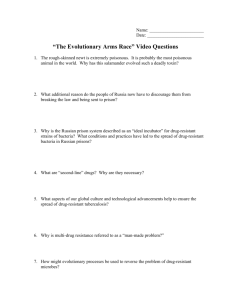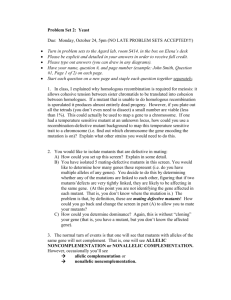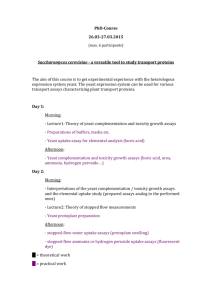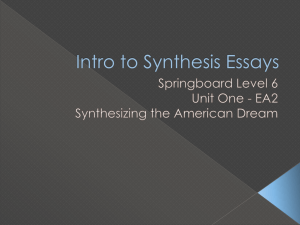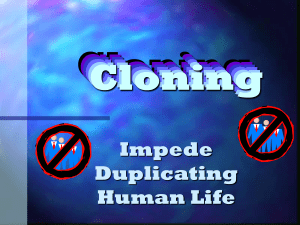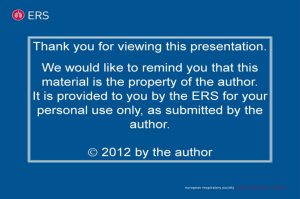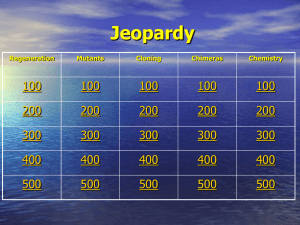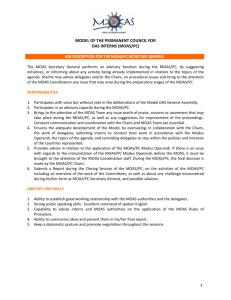Stella Snyder Bio 509- Molecular Bio Fall 2010 Introduction
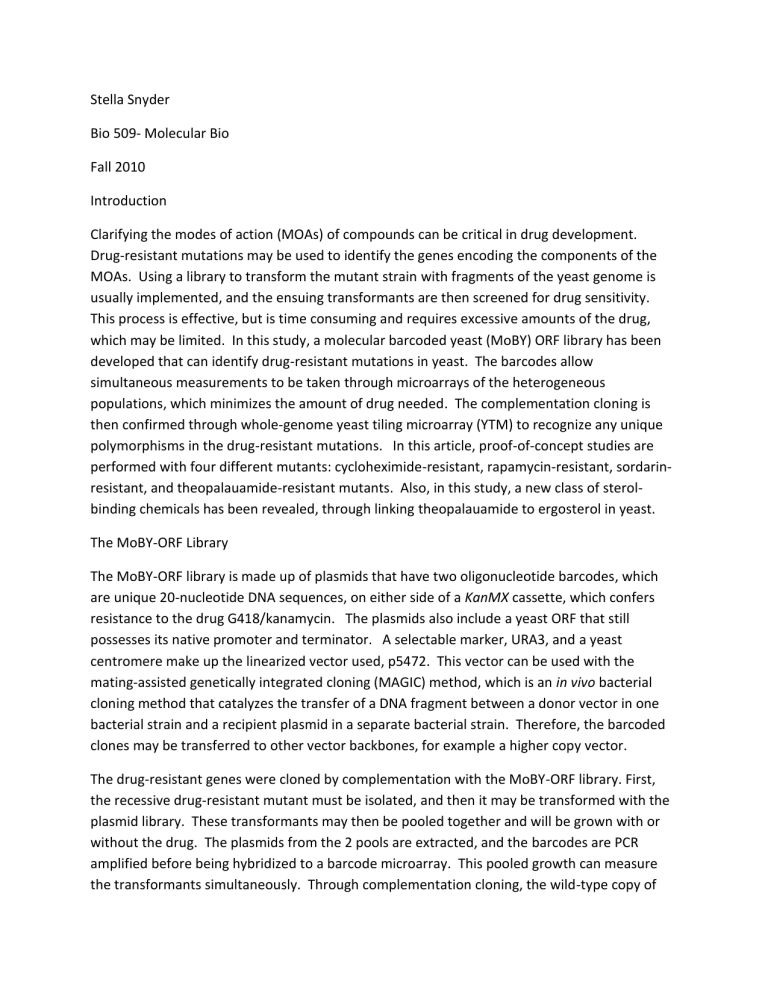
Stella Snyder
Bio 509- Molecular Bio
Fall 2010
Introduction
Clarifying the modes of action (MOAs) of compounds can be critical in drug development.
Drug-resistant mutations may be used to identify the genes encoding the components of the
MOAs. Using a library to transform the mutant strain with fragments of the yeast genome is usually implemented, and the ensuing transformants are then screened for drug sensitivity.
This process is effective, but is time consuming and requires excessive amounts of the drug, which may be limited. In this study, a molecular barcoded yeast (MoBY) ORF library has been developed that can identify drug-resistant mutations in yeast. The barcodes allow simultaneous measurements to be taken through microarrays of the heterogeneous populations, which minimizes the amount of drug needed. The complementation cloning is then confirmed through whole-genome yeast tiling microarray (YTM) to recognize any unique polymorphisms in the drug-resistant mutations. In this article, proof-of-concept studies are performed with four different mutants: cycloheximide-resistant, rapamycin-resistant, sordarinresistant, and theopalauamide-resistant mutants. Also, in this study, a new class of sterolbinding chemicals has been revealed, through linking theopalauamide to ergosterol in yeast.
The MoBY-ORF Library
The MoBY-ORF library is made up of plasmids that have two oligonucleotide barcodes, which are unique 20-nucleotide DNA sequences, on either side of a KanMX cassette, which confers resistance to the drug G418/kanamycin. The plasmids also include a yeast ORF that still possesses its native promoter and terminator. A selectable marker, URA3, and a yeast centromere make up the linearized vector used, p5472. This vector can be used with the mating-assisted genetically integrated cloning (MAGIC) method, which is an in vivo bacterial cloning method that catalyzes the transfer of a DNA fragment between a donor vector in one bacterial strain and a recipient plasmid in a separate bacterial strain. Therefore, the barcoded clones may be transferred to other vector backbones, for example a higher copy vector.
The drug-resistant genes were cloned by complementation with the MoBY-ORF library. First, the recessive drug-resistant mutant must be isolated, and then it may be transformed with the plasmid library. These transformants may then be pooled together and will be grown with or without the drug. The plasmids from the 2 pools are extracted, and the barcodes are PCR amplified before being hybridized to a barcode microarray. This pooled growth can measure the transformants simultaneously. Through complementation cloning, the wild-type copy of
the drug-resistant gene will complement the recessive mutation, and, in presence of the drug, these barcodes will prove to be depleted relative to the others in the pool.
To verify the gene associated with the drug-resistant mutation, a Yeast Tiling Microarray (YTM) and SNPScanner algorithm were used to find mutations within the parental strain or the drugresistant strain.
Mapping Mutants
Cycloheximide-resistant mutants were used as a proof-of-concept because mutations of
Rp128p, a component of the 60s ribosomal subunit, are known to confer resistance to cycloheximide. These mutants were mapped by both MoBY-ORF cloning by complementation and SNP scanning using YTM. The MoBY-ORF transformants that contained RPL28 were depleted roughly 13-fold (compared to the untreated control) in the presence of cycloheximide.
YTM analysis of the cycloheximide-resistant mutant revealed a single-base substitution within
RPL28, therefore supporting the results of the MoBY-ORF library.
Rapamycin-resistant mutants were also used to characterize this mapping system. Mutations in
FPR1, which encodes for FKBP12, confer resistance to rapamycin. MoBY-ORF complementation cloning showed plasmids with FPR1 were depleted by roughly 28-fold in the presences of rapamycin. YTM revealed 6 significant SNPs in the drug-resistant mutant. Therefore, again,
YTM analysis revealed FPR1 as the mutated gene that confers rapamycin resistance.
Mutations in EFT2, which encodes elongation factor 2, have been shown to produce sordarinresistant mutants. Using MoBY-ORF complementation cloning, plasmids with EFT2 were only depleted twofold in the presence of sordarin. This low depletion could be due to the gene’s association with only one barcode instead of two. YTM analysis did not show a polymorphism in EFT2, perhaps because paralog EFT1 has an almost identical sequence, which means there would be cross-hybridization , therefore blocking detection. However, direct sequencing of
EFT2 of the sordarin-resistant mutant revealed a single base-pair substitution mutation at nucleotide 1568. This shows that the MoBY-ORF approach can identify drug-resistant mutations in paralogs.
Theopalauamide and stichloroside are two compounds with similar chemical-genetic profiles and the same antifungal activities, but both with unknown MOAs. Mutants resistant to theopalauamide are also resistant to stichloroside. Using MoBY-ORF complementation cloning, a plasmid with MVD1 was identified, which encodes an important enzyme in the ergosterol biosynthesis pathway. However, YTM did not find a polymorphism in MVD1, though direct sequencing discovered a single nucleotide substitution within the active site of the enzyme.
There were two hypotheses for the MOAs of theopalauamide and stichloroside: Either the drugs directly inhibited the enzymatic activity of Mvd1p, or instead targeted the products of the
Mvdp1 pathway, such as ergosterol. To determine which hypothesis is correct, researchers examined a temperature-sensitive yeast strain, mvd1-ts, with a hypomorphic allele of MVD1 that has a mutation outside of the active site. If the hypomorph is more sensitive to theopalauamide and stichloroside, then the drugs must target Mvd1p directly. However, if a pathway product is targeted, then the hypomorphic mutant will show more resistance than the wild-type. The product-targeting hypothesis proved to be correct, as mvd1-ts was resistant to both theopalauamide and stichloroside.
Reduced Mvd1p activity, which lowers ergosterol levels, leads to drug-resistance. To see if theopalauamide and stichloroside bind to ergosterol, exogenous ergosterol was added to cultures with toxic levels of the drugs. Exogenous ergosterol proved to lower the toxicity of theopalauamide and stichloroside. Cholesterol behaved similarly, showing that it is the sterol backbone that is responsible. There are two well-characterized classes of sterol-binding compounds: polyene and saponin. Stichloroside’s structure lends itself to the saponin class; however, theopalauamide does not resemble any known sterol-binding compound. Therefore, theopalauamide belongs to a novel class of sterol-binding compound.
Conclusion
MoBY-ORF is an efficient chemical-genomic method of identifying mutated genes that confer resistance to certain drugs. This assay provides information on the MOAs of compounds and allows for the cloning of wild-type versions of drug-resistant mutant genes, using a minimal amount of the bioactive compound. The library has four significant characteristics. One, the
ORFs retain their own upstream and downstream sequences. Next, it allows for simultaneous measurements of the molecular barcodes within the vector. Also, most MoBY-ORF clones have only a single ORF, which is much easier to observe than the random fragments within other genomic libraries. Finally, the plasmid backbone and the barcodes of the clones may be transferred to a high-copy vector. Overall, this study confirms that the MoBY-ORF library is useful in its complementation cloning using the molecular barcodes for microarray readout.
